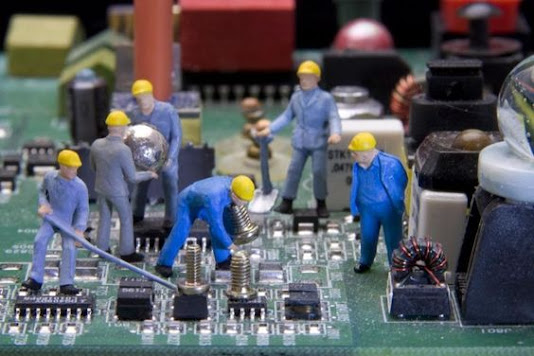Step 1: Update the BIOS
Before you remove your first screw, it is critical that you upgrade your BIOS to the latest version. Manufacturers often update BIOSs to allow support for newer CPUs. If you upgrade to a chip that’s newer than your BIOS allows, your notebook won’t boot at all. Check the support section of your manufacturer’s Web site for any BIOS updates for your notebook.
The process for upgrading your CPU is usually almost identical to that for upgrading your graphics board. In the case of the Inspiron E1505, the CPU resides directly underneath the video card assmbily so disassembly instructions are exactly the same for this part as for that one.
Step 2: Remove Any Cover Plates
Laptop designs vary, but the upgrade process usually begins with removing hinge covers: Pry up any plastic hinge cover and pull it away from the chassis. Avoid excessive force, as pulling too hard can break the plastic parts.
Step 3: Detach the Keyboard

Detach the keyboard by taking out the screws beneath the hinge cover that secure it, lifting it off, and then unplugging the connector. On some notebooks, simple latches allow you to remove the keyboard without unscrewing anything.
(Note: In a job like this, keeping track of where each screw came from is important. A good way to keep things organized is to use paper cups to hold the screws–one cup for each step of disassembly–and label each cup clearly.)
Step 4: Remove the Display Assembly
Remove the display assembly–the entire apparatus of the screen–by taking out the screws on the bottom and back of the portable, and unplugging the video and Wi-Fi antenna cables (pictured).
Next, pull out the optical drive; this usually means depressing the latch on the bottom of the laptop and sliding the drive out sideways.
Step 5: Remove the Shell
Remove the upper shell by taking the screws holding it out of the bottom of the PC. As you lift the shell off of the chassis, make certain that no part of it is still attached to the bottom of the case or to the motherboard. If it feels like you have to force it, that probably means either a screw is still in place or a clip remains to be unsnapped. Before continuing, back off and double-check your service manual to discover any well-hidden screws that may have eluded you.
Step 6: Remove the Graphics Card
We’ve now reached the part of the upgrade that involves actually laying hands on critical system components, so be sure you’re wearing an antistatic wrist strap and are well grounded before continuing. Obviously, you’ll have to use care in handling any components that you touch.
On our laptop, the preceding steps gave us access to the graphics card assembly, which we removed by loosening two screws. The CPU sits beneath that card.
Step 7: Remove the Heat Sink
Turn the CPU socket’s locking screw counterclockwise until it stops, and lift the CPU straight up and out of the laptop. Drop the new CPU in, but don’t push it (if it looks as though it needs a push, it isn’t aligned properly). Turn the screw clockwise to lock it. Note: Some systems use a locking bar in place of a screw.










Social Plugin